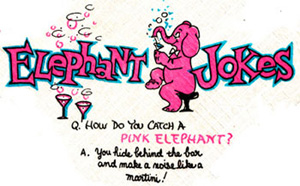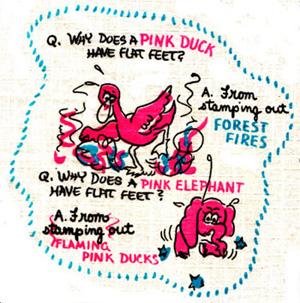Heavy Metal Madness: Seeing Pink Elephants

It’s the holidays and that means company Christmas parties, acrimonious family gatherings, tree-decorating get-togethers and New Year’s Eve celebrations. And for many, those events are accompanied by a few, or by many, cocktails. And though we have, in recent years, taken a slightly more critical look at alcohol consumption, that wasn’t always the case.
The art of drinking has manifest itself in a variety of images, depending on the times. For the majority of the last century, drinking and drunkenness was considered a humorous sport, and the images, on the whole, had a comic and playful look. From tipsy pink elephants to happy drunks clinging to a lamppost, most drinking art showed few, if any, consequences to imbibing. And a whole new vocabulary was created to describe the various states of inebriation.

Figure 1: Holidays bring out the drinker in everyone, as illustrated here in a 1967 San Francisco Chronicle photo used to illustrate a special section on how to drink.
It wasn’t just art that promoted excessive alcohol consumption. The entertainers of the day played their role too. Dean Martin sipped cocktails during his TV show, Foster Brooks made a career out of his drunken persona, and in the early days, Hugh Hefnerwas almost always pictured at the Playboy mansion, cocktail in hand. For the generations that came of age in the ’30s, ’40s and ’50s, drinking was a pastime, a hobby, and a passion. Kind of like coffee and Red Bull are now.

Figure 2: Being sloppy drunk is even funnier if you’re a mouse, as shown in this cocktail napkin from the ’50s.
There’s Something About an Elephant
It’s a little unclear why pink elephants have been associated with drinking for a number of decades, but they are one of the more consistent images. I found one reference to seeing pink elephants and pink spiders as a drinking hallucination, attributed to the 1890s. In 1913 Jack London wrote in “John Barleycorn“: “There are, broadly speaking, two types of drinkers. There is the man whom we all know, stupid, unimaginative, whose brain is bitten numbly by numb maggots; who walks generously with wide-spread, tentative legs, falls frequently in the gutter, and who sees, in the extremity of his ecstasy, blue mice and pink elephants. He is the type that gives rise to the jokes in funny papers.”

Figure 3: For some reason, pink elephants were the most popular image for drinking during several decades, beginning in the ’40s.
And then in 1932, Guy Lombardo had a popular hit with the song “Pink Elephants” composed by Mort Dixon and Harry Woods. Sample verse:
Pink elephants on the chair.
Pink elephants on the ceiling,
Pink elephants ev’rywhere. Now I’m through making whoopee,
I raised my hand and swore
That I never intend to see
Those pink elephants any more.
It should be noted that the song also referred to a lavender alligator, a purple cow, a polka-dot boa constrictor, a beetle, a monkey, and a whippoorwill. But it was the pink elephant that stuck.

Figure 4: Even an elephant can’t disguise being drunk-it’s all in the eyes.

Figure 5: In 1943, a pink elephant could drink and ride a bike at the same time, as demonstrated in this cocktail napkin found at a garage sale.
By 1941, pink elephants were everywhere, including in the Disney movie “Dumbo,” which features a famous scene called “Pink Elephants on Parade.” That drunken-elephant sequence also inspired a drink of the same name, which consists of 2 oz. Vodka, 4 oz. Pink lemonade, 2 tbsp. Sugar and .5 oz. Midori melon liqueur.

Figure 6: Not sure if this 1944 pink elephant is sad because it’s also drunk, or because it’s not.

Figure 7: Both hosts and guests suffered come Sunday after a weekend bender.
At about the same time pink elephants became an image for the effects of over drinking, elephant jokes became a pop phenomenon as well. That led inevitably to pink elephant jokes-the best of both worlds.


Figures 8 and 9: Combine pink elephants and elephant jokes and you have a riot fest, as shown in this napkin from 1965.
Learning to Hold Your Liquor
It’s no wonder so many references are made to drunken behavior in the decades preceding the ’70s. In the 1964 Calvert Party Encyclopedia it is suggested that at a typical party, the hostess should calculate an average of three to four cocktails per guest, at a rate of one and a half oz of gin or whisky each. That’s five and a half to six ounces of high-proof alcohol each. Depending on the length of the party, this would easily put every guest over the current legal limit for driving. And when you consider the size and weight of American cars at the time, that’s pretty scary.

Figure 10: As late as the ’60s, drunks were still pretty happy as illustrated in this card deck, each festooned with a different drinking cartoon on the back.
Of course being plied with six ounces of gin may have been the only way guests could endure the inevitable party games as suggested by Calvert. Aside from the well-known charades and eye spy games, the Party Encyclopedia includes instructions for “Talkathon,” a hilarious exercise where guest A is given an ice cube and has to hold it as long as guest B continues talking non stop. If guest B stops talking, then guest A hands the melting cube to them and begins talking non stop themselves. It’s not clear who wins or loses this match when the cube finally melts, but you can imagine the laughter and gaiety that unfolds.

Figure 11: Drunks and lampposts have gone together since lampposts were invented.
And if you’re worried about the melted ice staining your hardwood floors, you can always play “Jumbled Words.” In this laugh fest you scramble the names of popular movie titles, famous people, etc, and set your guests loose trying to figure out the right phrase or name. Calvert suggests such brain teasers as:
(George Washington)
NEOG HIWT HET DNIW
(Gone With the Wind)
OWSN ITHEW DAN ETH VNEES RAWFSD
(Snow White and the Seven Dwarfs)
This article was last modified on May 19, 2023
This article was first published on December 11, 2003



